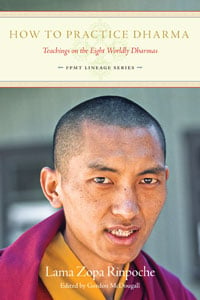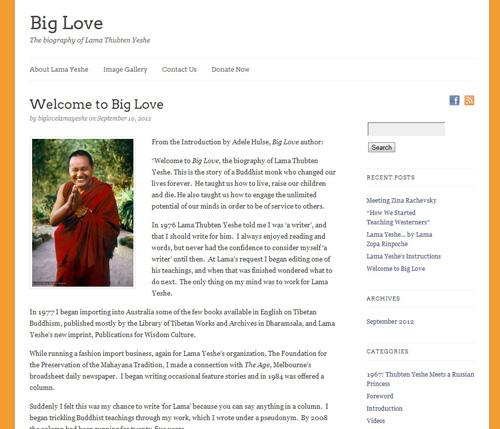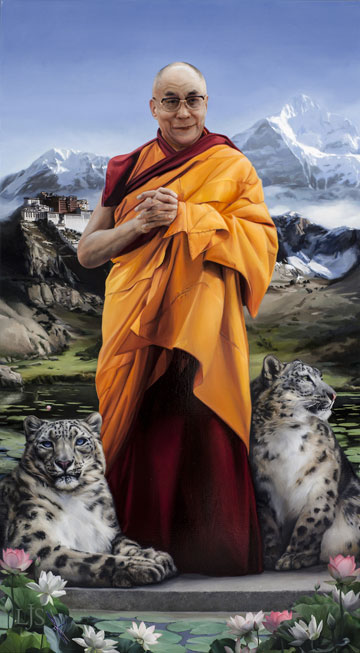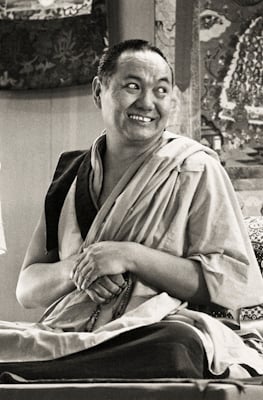Dear LYWA friends and supporters,
Thank you once again for your kind interest in the Lama Yeshe Wisdom Archive. Please share this eletter with your friends and center members... we would love for as many people to see it as might be interested.
Also, if you’re on Facebook, please remember to like our page and share it with all your own friends. We recently passed the 5,000 "likes" milestone and now have our sights set on 10,000! So we’re depending on you to help get us there. Thank you so much.
How to Practice Dharma Everybody is loving Lama Zopa Rinpoche's new book How to Practice Dharma: Teachings on the Eight Worldly Dharmas. Here’s a great message sent out by Jamyang Buddhist Centre to their list:
Everybody is loving Lama Zopa Rinpoche's new book How to Practice Dharma: Teachings on the Eight Worldly Dharmas. Here’s a great message sent out by Jamyang Buddhist Centre to their list:
You just have to buy yourselves a copy of the latest book by Lama Zopa Rinpoche called How to Practice Dharma: Teachings on the Eight Worldly Dharmas. It is the latest in the FPMT Lineage Series....
The first book in the series was on Buddhist tantra guru devotion [Heart of the Path]. This practice is often difficult for people brought up in the scientific questioning European liberal democratic tradition, and some people get stuck there. If you are one of those, we ask you to just park your reservations for awhile (don't worry they'll be back!) and look into this volume....How to Practice Dharma is just extraordinary. So practical, so true. The kind of book that helps you recognize and laugh at your nonsense and gives you the resolve and techniques to stop being such a twit/nelly/nincompoop so often.
Buy the book, read it, laugh at your nonsense and grow. Thank you so much to Lama Yeshe Wisdom Archive, the publisher, and Gordon McDougall, the editor, for bringing this into the light of day. A real joy from beginning to end.
This book would make a great text upon which to base introductory courses at centers... and, it’s only $10 and center bookstores get a 50% discount. Please let us know if you’re interested.
For individual copies, you can order the book on our website. See our website also for links to the many ebook vendors where you can purchase the book for $5, including Amazon. com, Apple, Barnes & Noble, Sony and more.
Big Love Blog  Editing work continues in earnest on Lama Yeshe's biography Big Love.
Editing work continues in earnest on Lama Yeshe's biography Big Love.
To give you all a taste of this incredible account, we have started a Big Love Blog where we will be posting excerpts from the biography. Check it out and be sure to follow it so you can keep up with all the new postings as they are made.
An excerpt from the chapter on 1977 is this month's eletter teaching below.
And speaking of stories of Lama, we have just posted Lama's address to FPMT Center Directors in 1983 where he talks about why FPMT Centers were established and how they should be organized.
What Else is New on our Website
Our web editor Sandy Smith has outdone herself this month, posting many incredible teachings, each one more precious than the last:
- The Benefits of Stupas: Lama Zopa Rinpoche gave this teaching at Atisha Centre, Bendigo, Australia in March 2000. Included is a discussion with the architect and artists for the Great Stupa of Universal Compassion, which is being built near Bendigo and will be the largest stupa in the Western world.
- The Preliminary Practice of Tong-len: This advice on the practice of tong-len was dictated by Lama Zopa Rinpoche in 2006; also included is a short tong-len practice compiled on the basis of Rinpoche's instructions.
- The Benefits of Vajrasattva Practice: This pair of teachings includes Lama Zopa Rinpoche teaching on the benefits of the practice, and Lama Yeshe teaching on the benefits of purification with Heruka Vajrasattva.
- The Benefits of Making Prostrations: Another pair of teachings, both by Lama Zopa Rinpoche, on the benefits of making prostrations and a commentary on the practice.
We have also posted precious audio of Rinpoche speaking to a group of students at a refuge ceremony at Jamyang Meditation Centre, London, in November 1992. The style is very up close and personal, a truly unique recording.
As usual we added a number of new advices to Rinpoche's Online Advice Book, including advice on daily practice, a note to a student about how important it is to meditate every day on the lam-rim, advice on healing with Medicine Buddha practice, and more. You can see a list of all new advices added last month.
A Portrait of HH the Dalai Lama Lisa Sawlit, an artist with whom I used to work at Wisdom Publications and who designed some of LYWA’s earlier books, has painted a staggeringly beautiful portrait of His Holiness. The current issue of Nantucket Magazine has an interview with her about it.
Lisa Sawlit, an artist with whom I used to work at Wisdom Publications and who designed some of LYWA’s earlier books, has painted a staggeringly beautiful portrait of His Holiness. The current issue of Nantucket Magazine has an interview with her about it.
As you may know, His Holiness will be in Boston soon and is coming to Kurukulla Center, where we will ask him to bless the painting.
The History of Buddhadharma in the West
This is a new film "When the Ironbird Flies" about Dharma coming to the West. You can view a 20-minute preview here. It’s having its premier at the Rubin Museum, New York, Friday October 19. I’ll be talking about the film and its message and answering questions after the 6 pm October 20 showing; see this flyer for more information. Hope to see some NY area friends there!
The latest issue of the FPMT’s Mandala magazine has an interview with me about LYWA’s FPMT Lineage Series of books, of which How to Practice Dharma is the second. Check it out to learn how we started publishing in the FPMT and how Wisdom Publications and LYWA began. There’s more on all that in a chapter I wrote a number of years ago for a book called The Path of the Buddha.
More recently there's a chapter that I wrote for the new book Inner Peace - Global Impact: Tibetan Buddhism, Leadership and Work. You can read what I wrote here, a personal account of my time with Lama Yeshe as he was introducing Buddhism to many Western students. The publisher is offering the book for only $20 post-free (within the USA) until the end of September, so if you’d like a copy, please rush!
Thank you again for all your amazing support of the Archive, as we preserve and spread these precious teachings of the Lamas.
Much love, 
Nick Ribush
Director
This Month's Teaching: Lama Yeshe's Biography: 1977
 Early 1977
Early 1977
In January 1977 Lama Yeshe called Nick Ribush into his room at Kopan and said, “I think we need a center in Delhi.” He instructed Nick to create one there. “Unbeknownst to me Lama had already said the same thing to Sunita Kakaria at the end of the 1976 course,” said Nick. “She was really our only Indian contact at that stage.” Nick began spending most of his time in Delhi.
During that same month, Connie Miller, who was still living at Kopan and teaching English to the young monks, received a telegram from home. Her father had become seriously ill with lung cancer and her family wanted her to come home. Over the past year while living and studying in Nepal, working with Mummy Max in both Kathmandu and Delhi, and teaching the Mount Everest Centre monks, she had developed a strong commitment to Kopan and to Lama Yeshe and his work.
Before leaving for the States, she asked Lama what she could do to help. “My children are cold and sick, they need many things,” Lama Yeshe said to her. He promptly gave her the nominal title of “director” of Mount Everest Centre and asked her to fund-raise for “his boys” who at that time numbered around eighty.
Connie flew back to the United States in February. Happily, when she arrived home she found that her father was doing somewhat better due to the medical treatment he was receiving. Having become a close friend to Karuna Cayton during their time in Nepal, she took a job working for his father’s company in Los Angeles and used her spare time to raise funds for Mount Everest Centre.
Lama tailored his advice to his students’ personalities. In February, after completing eighteen months of undergraduate study in Nepal, Karuna was about to return home to California. Lama invited him for breakfast on his last day and Karuna asked whether he should return to Kopan. Lama told him, “Dear, I never give my students advice. So when you come back to Nepal I want you to run the English program for the boys.” Despite the obvious contradiction, Karuna knew exactly what Lama wanted him to do. When he returned to Kopan in August 1978, Karuna enrolled in a graduate program, this time working toward his Master’s degree in Teaching English as a Second Language. He was thus able to obtain another student visa awhile later that allowed him to return to Nepal, residing there and working for Kopan for another ten years.
Lama Yeshe’s Sangha disciples
Since Geshe Jampa Gyatso’s teachings had begun the previous December, the Sangha had been busily memorizing the Abhidharmakosha and receiving teachings every day. Nevertheless, one night in his room Lama Yeshe told Peter Kedge and Mummy Max that he really only had one disciple. They knew who that was. Meanwhile, Lama chipped away at the egos of his other students.
The previous year, Mummy Max had moved her fashion business to Delhi, Roger Wheeler had retired from doing business in Kathmandu and Marcel Bertels had started doing business in his place under Lama Yeshe’s direct guidance. Yeshe Khadro was still in Australia.
Thubten Pemo was recovering from hepatitis at Kopan and could not eat the oily food from the kitchen. “Just when I thought that I might die, someone came to the nuns’ dormitory (Zina’s old room) and said that I could see Lama Yeshe. I was so weak and hungry that when I finally got upstairs to his room I just fell down. Lama exclaimed, ‘Why didn’t you tell me she was so sick!’ I told him I thought I might die and he said, ‘You cannot die! You have to help sentient beings. Look at me,’ he said and pointed to his chest. ‘My heart has not worked for ten years and I am still alive! I make signature [guarantee] that you are not going to die!’
“He told me to wait and returned nearly an hour later with a big tray filled with food he had cooked for me himself. He told me to come into his big room where he was having a meal with Rinpoche, Lama Lhundrup and Lama Pasang. Lama said he wanted to watch me eat. I could only eat half of what he gave me. He told me to take the rest away and eat it later and to return for breakfast in the morning. I ate with the lamas for the next few days. If Lama Yeshe saw me walking by he gave me an apple. At one stage he took my pulse, just like a Tibetan doctor does. Then he said, ‘Almost dead.’ I did not know whether to laugh or cry.”
Lama Yeshe told Pemo that the food in Nepal was not strong or nutritious enough to help her to get well so he sent her to England to Manjushri Institute with instructions to help Nicole Couture [Kedge]. She was the second nun to arrive at Manjushri Institute. Lama had also asked her to start a magazine to connect all his students around the world. She duly tried to collect articles and teachings from various students and the centers that existed at that time but it seems that most centers were just starting to be organized and often didn’t even respond to Pemo’s requests. Once again, Lama’s enormous vision seemed to be far ahead of his students’ reality.
Lama also sent Dieter Kratzer to Manjushri; Dieter arrived there three months after Thubten Pemo’s arrival. He sent Jon Landaw and Petey Shane, his acting secretary, off to Geshe Sopa in Madison, where he would join them later in the year.
Next Lama turned his attention to his French nun Elisabeth Drukier. She didn’t want to leave Kopan. “You have to visit your family,” Lama told her. “You have to connect again.” “He often told me to pray at the Tara statue over the little pond, to gain confidence,” said Elisabeth. “He told me, ‘Since Kopan was built I don’t worry about anything because Mother Tara is there, taking care.’ When I fell ill, which wasn’t hard to do at Kopan, he told me to go to the gompa and drink some of the water from the bumpa vase, the ritual water holder that stands on the altar. He called it dakini water.”
As the lamas prepared to go on tour again, Thubten Pelgye (John Douthitt) made a special prayer. “Back in America I’d been a professional cook. I prayed then that at some time I would be able to cook for the lamas on tour. I was a new monk and was convinced that my prayer would come true because it felt so forceful,” he said. It did come true, but not quite in the manner that Pelgye hoped for.
On tour again
The lamas and Peter arrived in Delhi with just a few hours to spare before they were to fly out, during which time they had a number of things to get done: collect books to carry on tour and reorganize their luggage, among other things. “We always carried copies of the lamas’ first book, Wisdom Energy, with us,” Peter reported. “In 1977 Lama’s new imprint, Publications for Wisdom Culture, for which Lama Zopa Rinpoche had made a disarming little drawing of a flying monk as its logo, produced a second book, Advice from a Spiritual Friend by Geshe Rabten and Geshe Ngawang Dhargyey. Lama had negotiated with his student Brian Beresford to work on that book and had paid him a small amount. I drew up the contract on Lama’s behalf. The book was printed in Delhi by a friend of Sunita Kakaria. So now we had two titles to carry around; the books took up two entire suitcases.” On top of everything else, however, Lama wanted to buy a Jeep for Tushita that very evening!
“As usual we were staying in the Akbar Hotel in Delhi, which is now long gone. I asked another student to go out and buy us two suitcases for the books because I had to rush off and buy this Jeep,” Peter recalled. “We ended up in Old Delhi looking at an old Jonga Jeep that had been repainted a kind of pea green. Mummy Max came with us and we took it out for a run. The gearbox got very hot. Right from the start Max thought it was a lemon. However, Lama insisted that we buy it. At around 9:00 pm we struck a deal with the person selling it—who was highly suspect.
“A few months later when I returned to Delhi, I drove it up to Dharamsala with Lama’s brother, Geshe Thinley. It was a dreadful drive. When we finally got to Dharamsala all the diesel fuel froze in the lines. We had to light a fire under the tank every time we wanted to start the thing. After a couple of weeks I took it down to Pathankot, drove around with a ‘For Sale’ sign on it and sold it for more or less what we paid for it. I was very pleased that we were rid of it.
When we got back, I packed the books into the suitcases, and then I called the bell captain when it came time to leave for our middle of the night flight. He bent to pick up the suitcases and when he lifted them, both handles immediately tore right off. We had no time for anything else so we tied them up with string and carried them around the world like that.”
On 11 February 1977 the lamas and Peter Kedge flew into London en route to the United States. Harvey and three other Manjushri Institute residents drove from Cumbria to Heathrow Airport and back, a day’s solid driving, just to spend an hour with Lama Yeshe. The utterly daunting task of running the enormous, unbelievably cold, damp and rotting Priory had begun to oppress the twelve residents. They had been there a year now and were just beginning to discover the full extent of the dry rot. Lama’s message for them was, “You can do!” “Just that was enough to fill us with confidence,” said Harvey.
In Italy Lama Yeshe had asked Massimo and two others to find a new home for Istituto Lama Tzong Khapa. Geshe Rabten kindly assisted them by making observations (mos) regarding locations where they should search. After looking at more than a hundred properties they came across a small nineteenth-century castello about an hour away from Pisa in Tuscany. Massimo sent photos of the property to Lama Yeshe in New York and Lama immediately gave them the go-ahead to buy it. True to his word, Massimo’s father put up the money for most of the purchase cost as well as most of the cost of the subsequent renovations and in March 1977 Istituto Lama Tzong Khapa had a new home.
The new center was located in the lush and rolling hills of Tuscany, where fields of sunflowers and wheat alternate with groves of tall cypress and pine trees. The castello was a large L-shaped building constructed of light-colored rough-hewn stone with a traditional terracotta roof, located only twenty minutes away from the Mediterranean seaside. The closest town to the center was called Pomaia, a tiny village with only a few hundred residents.
A month after the building was acquired, eight students, including Massimo and his wife Carol, moved into the still partially rented building. They all slept together in one room, while preparing other parts of the building for Geshe Rabten’s visit in May. After his course on The Seven-Point Thought Transformation, two more students moved in, followed in July by the center’s “democratically” elected spiritual program director, Piero, and secretary, Claudio.
Excerpted from the forthcoming biography of Lama Yeshe Big Love, by Adele Hulse, edited by Ven. Connie Miller, due in late 2013. To read more excerpts from the biography visit our Big Love Blog.





























